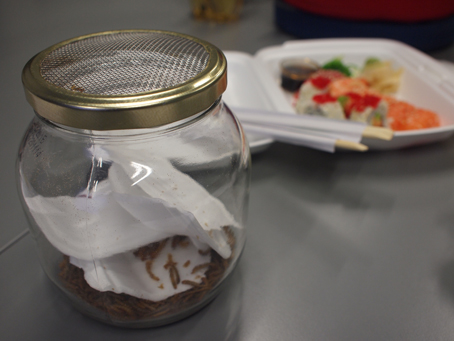Vulnerability by Design: Environments, Animals
- Start Page
- Calendar
- Vulnerability by Design: Environments, Animals
A seminar series on the ethics and politics of design engagement across borders, bodies and environments

Composting plastics in a domestic setting, workshop hosted by Kristina Lindström and Åsa Ståhl as part of the project HYBRID MATTERs. Photo by Kristina Lindström.
Date: Tuesday 22 October 2019
Time: 5.00–7.30 pm
Place: Konstnärsnämnden, The Project Room
Address: Maria skolgata 83, Stockholm, Sweden
Language: English
Welcome to the first public seminars in this series where Mauricio Corbalan, Don Kulick, Åsa Ståhl and Kristina Lindström together with Mahmoud Keshavarz will discuss the ethics of engagement and relationship with other than human species like animals or pests.
Vulnerability by Design explores the intersections of what forms of human, animal and environmental vulnerabilities are engaged, resisted and/or produced by design and designing and how the vulnerability, partiality and limits of design and designing are exposed through various tactics and techniques. It poses an urgent question: what methodologies and knowledge are required to recognize the ethics and politics of design engagement with our and others’ vulnerable conditions? Through three main themes of borders, bodies and environments, these questions and concerns will be highlighted and discussed in a series of seminars with Swedish and international guests.
In the recent decade there has been a proliferation of design practices that engage with the vulnerability of different individuals, groups and beings from humans to animals and environments. These design practices often aim to overcome or resist the vulnerable conditions in which they intervene. In doing so, they often rely on one of the main capacities of designing, in speculating, imagining or envisioning possible relations, arrangements and configurations between existing situations and possible futures.
In these processes, however, there are many assumptions and ambiguities around what constitutes a status as vulnerable which calls for a designerly intervention. Who and under what conditions claims the less vulnerable position from which others can be approached as more vulnerable and in need of a better design? Is design merely a tool separated from the conditions of vulnerability, which it seeks to address? Is there a risk that through engaging with such conditions, the act of designing would generate other vulnerabilities often not recognized by the designers? Furthermore, how does materiality, partiality and limits of designing make design also vulnerable in its own way?
Mauricio Corbalan is a Buenos Aires based architect, researcher and together with Pio Torroja co-founder of m7red. The practice is engaging with how cities and territories are nowadays reorganized by data, gender and species. These categories are effectively reshaping cities today I contrast of those that shaped public space during the age of modernism. The merging of ethics and design, the crisis of scientific knowledge and the raising of the metadata society has radically altered the way of understanding complex urban phenomena.
Don Kulick is Distinguished University Professor of Anthropology at Uppsala University and head of the Engaging Vulnerability research program.
His research and writing cover a variety of topics and disciplines, including sociolinguistics, gender and sexuality studies, disability studies and queer theory. He has published on language socialization, language death, indigenous forms of Christianity, sex work and prostitution, reflexive epistemology, fat studies, and animal studies. He has conducted extensive anthropological fieldwork in Papua New Guinea, Brazil, and Scandinavia.
Åsa Ståhl and Kristina Lindström are funders of the Un/Making Studio, financed by the Swedish Research Council, with the aim of exploring alternatives to progressivist and anthropocentric ways of thinking and making within design. With a base in participatory and speculative design in combination with feminist technoscience their work engages with publics throughout their research process and exhibition makings. Åsa Ståhl is a Senior Lecturer in design at Linnaeus University, Växjö, Sweden. Kristina Lindström is a Senior Lecturer in design at the School of Arts and Communication at Malmö University.
Vulnerability by Design is part of a new public events programme at Iaspis, critically looking at how socially engaged practices within design, craft and architecture may engage with urgent societal issues. The programme unfolds through various themes and formats from the autumn 2019. Vulnerability by Design is developed by Iaspis, the Swedish Arts Grants Committee’s international programme for Visual and Applied Artists through Project Manager Magnus Ericson and together with Mahmoud Keshavarz, researcher at the Engaging Vulnerability Programme, the Department of Cultural Anthropology and Ethnology, Uppsala University.
For further questions please contact Magnus Ericson: me@iaspis.se

